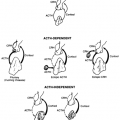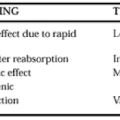TREATMENT OF OBESITY
Part of “CHAPTER 126 – OBESITY“
WEIGHT-REDUCTION MEASURES
In most obese individuals, specific aberrations of the weight-control mechanism described under Pathogenesis cannot be identified and, thus, treatment must be nonspecific. Short-term weight loss often can be achieved, but obese patients tend to regain their lost weight: Only ˜20% of obese patients maintain their weight loss over a 5- to 15-year period after initial treatment.32 Greater success is likely to be achieved through programs that lead to permanent changes both in eating habits and in physical activity. Achievement of this goal requires new approaches that extend beyond the confines of traditional medical settings, involving not only the physician but also various nonphysician resources in the community.
It is important to remember that obesity is a medical as well as a cosmetic problem. Treatment should be considered for all with a BMI in excess of 27 or with lesser degrees of obesity in those with associated disorders, such as type 2 diabetes, hyperlipidemia, cardiovascular disease, hypertension, gout, pulmonary disease, and severe osteoarthritis.
Management of type 2 diabetes associated with obesity requires not only aggressive control of blood glucose with pharmacologic agents, but also healthy nutrition, weight reduction, and exercise. Weight loss in overweight, obese individuals with type 2 diabetes (even if only partially successful) is imperative in the treatment of type 2 diabetes. As little as 5% weight loss has been shown to improve blood glucose and lipid levels in overweight and obese type 2 diabetics.
DIETARY THERAPY
The cornerstone of treatment is dietary therapy (see Chap. 124). Weight loss depends on caloric deficit, and caloric deficit depends on the total number, not the kind, of calories consumed relative to calories expended. Many different types of calorie-restricted diets have been advanced for the treatment of obesity, some of which are in the form of liquid formulas, and others that use bizarre combinations of foods or nutrients based on unfounded theories that may be hazardous. None of these fad diets offers advantages over a calorie-restricted diet of normal foods that is balanced to provide the conventional distribution of carbohydrate (45–50% of total calories), fat (35% of calories), and protein (15% of calories). Low-carbohydrate, high-fat, ketogenic diets and diets very high in protein cannot be recommended for long-term treatment of obesity. The more rapid initial weight loss induced by some fad diets during the first few weeks of treatment is secondary to a loss of sodium, water, and body protein rather than fat, and after the first 2 or 3 weeks, the rate of weight loss may be disappointing. Furthermore, these diets can be associated with serious health hazards.33 Finally, the ingestion of unbalanced diets does nothing to modify eating habits or to develop healthy long-term nutritional practices, which are essential for successful long-term management of obesity.
The extent to which calories should be restricted in a given patient depends on the degree of obesity and the age, sex, physical activity, and general health of the patient. A loss of ˜2 pounds per week is a reasonable goal in most patients and can usually be accomplished by a daily deficit of ˜1000 kcal. If the obesity is associated with severe, debilitating, or life-threatening disease, such as the pickwickian syndrome, severe congestive heart failure, or severe hyperglycemia, a more drastic reduction in calorie intake may be indicated.
EXERCISE
Daily exercise is an important adjunct to caloric restriction in achieving and maintaining reduced weight. However, exercise is not an effective means of inducing weight loss unless combined with the reduction of caloric intake. When combined with a hypocaloric diet, a daily exercise program, carefully planned and tailored to the patient’s physical condition and ability, is important for long-term weight reduction. However, a sudden increase in physical activity in obese patients or a strenuous exercise program is hazardous and contraindicated. Exercise should begin gradually in the form of a low-level aerobic activity such as walking, swimming, or cycling. After normal or near-normal body weight is achieved, the degree of physical activity can be increased, depending on the patient’s physical condition (see Chap. 132).
Stay updated, free articles. Join our Telegram channel

Full access? Get Clinical Tree





